The Multi-tenant Data Centers Market is estimated to be valued at USD 63.3 billion in 2025 and is projected to reach USD 213.0 billion by 2035, registering a compound annual growth rate (CAGR) of 12.9% over the forecast period.
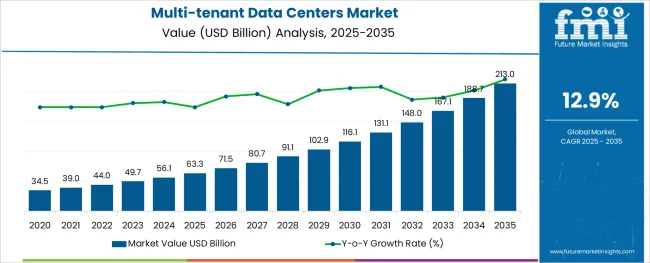
The multi-tenant data centers market is growing rapidly as businesses increasingly seek flexible and scalable infrastructure to support digital transformation. Rising adoption of cloud computing and demand for data storage and processing capabilities have fueled this growth. The need for cost-effective IT infrastructure that can handle variable workloads has made retail colocation solutions highly attractive.
Advances in data center design and energy efficiency have improved operational performance and reduced costs. Additionally, regulatory compliance requirements and the need for robust disaster recovery solutions have driven demand for multi-tenant facilities.
Public cloud applications are growing, creating more reliance on data center services that provide secure and scalable environments. The market is expected to continue expanding as enterprises prioritize agility and uptime. Growth is projected to be led by retail colocation in solutions, solutions as a key component, and public cloud as the main application.
The market is segmented by Solution, Component, Application, Organisation Size, and Industry and region. By Solution, the market is divided into Retail Colocation and Wholesale Colocation. In terms of Component, the market is classified into Solutions and Services. Based on Application, the market is segmented into Public Cloud and Private Cloud.
By Organisation Size, the market is divided into Large enterprises and Small & Medium Enterprises. By Industry, the market is segmented into IT & Telecom, BFSI, Healthcare, Government & Defence, Manufacturing, Retail, and Others. Regionally, the market is classified into North America, Latin America, Western Europe, Eastern Europe, Balkan & Baltic Countries, Russia & Belarus, Central Asia, East Asia, South Asia & Pacific, and the Middle East & Africa.
The market is segmented by Solution, Component, Application, Organisation Size, and Industry and region. By Solution, the market is divided into Retail Colocation and Wholesale Colocation. In terms of Component, the market is classified into Solutions and Services. Based on Application, the market is segmented into Public Cloud and Private Cloud.
By Organisation Size, the market is divided into Large enterprises and Small & Medium Enterprises. By Industry, the market is segmented into IT & Telecom, BFSI, Healthcare, Government & Defence, Manufacturing, Retail, and Others. Regionally, the market is classified into North America, Latin America, Western Europe, Eastern Europe, Balkan & Baltic Countries, Russia & Belarus, Central Asia, East Asia, South Asia & Pacific, and the Middle East & Africa.

The retail colocation segment is expected to hold 53.4% of the multi-tenant data centers market revenue in 2025, securing its position as the dominant solution type. This segment has grown because it allows multiple customers to lease space, power, and cooling in a shared facility while maintaining control over their own equipment.
Businesses have favored retail colocation due to the balance of cost savings and control it offers compared to building private data centers. The flexibility to scale capacity on demand has made it popular among companies with fluctuating workloads.
Moreover, retail colocation facilities often provide enhanced security and compliance features that meet industry standards. The ability to leverage existing infrastructure without large capital expenditure supports continued adoption. This segment is expected to maintain its lead as enterprises seek scalable and reliable data center solutions.
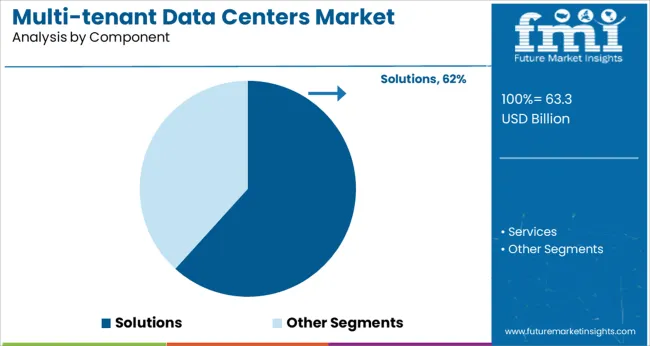
The solutions segment is projected to contribute 61.7% of the market revenue in 2025, emerging as the leading component category. Growth in this segment has been driven by the demand for integrated services including network connectivity, power management, and monitoring systems that enhance data center operations.
Customers increasingly require turnkey solutions that offer end-to-end management and support, simplifying complex IT environments. Advances in software-defined infrastructure and automation tools have boosted the adoption of comprehensive solutions.
Providers offering scalable and customizable packages have gained competitive advantage. The need for rapid deployment and efficient management of multi-tenant environments continues to drive this segment. With technology evolving toward greater integration and service orientation, the solutions component is expected to dominate the market.
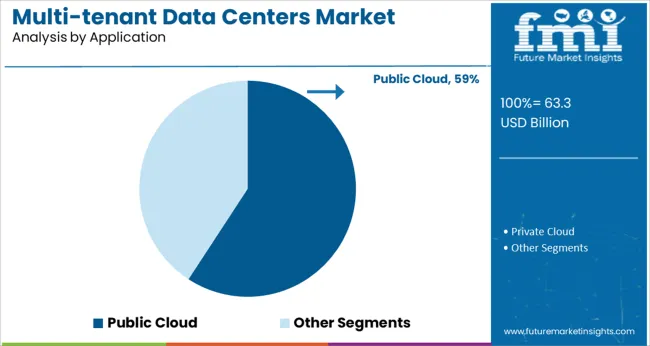
The public cloud segment is projected to account for 59.2% of the multi-tenant data centers market revenue in 2025, making it the primary application driver. Growth in this segment has been fueled by enterprises migrating workloads to public cloud platforms for scalability, flexibility, and cost efficiency.
Multi-tenant data centers provide the physical infrastructure necessary to support the massive data and processing demands of public cloud services. The rise of cloud-native applications and digital services has increased reliance on data center resources.
Furthermore, the public cloud supports a wide range of industries including retail, healthcare, and financial services, expanding market opportunities. The need for secure and compliant cloud hosting environments also boosts demand. As public cloud adoption continues to accelerate, this application segment is expected to lead market growth.
The multi-tenant data centers are mainly meant for offering much output using very few resources. This helps in minimising capital expenditure. This is something which company looks forward to as it helps them to utilise this for some other useful investment. This is expected to increase the demand for multi-tenant data centers market.
Moreover, the multi-tenant data centers have this attribute of offering quick solution for any given business problem. This gives room to the managers to take the decision efficiently, thereby increasing the profit for the company. This is anticipated to increase the sales of multi-tenant data centers market.
The Internet is expanding faster than ever before. With the growing internet, the data, be it from the primary source or secondary source is also increasing. It becomes crucial to handle this data, so that the organisations can make the best use of this data, and create the appropriate product/service. This is expected to increase the demand for multi-tenant data centers market.
Apart from internet, even the IoT space, AI and ML sectors are also expected to rise rapidly in the given times. All this can be attributed towards the development of Web 3.0 by the technological giants.
The companies that are into development of Web 3.0 and related technology would certainly require the multi-tenant data centers. These would effectively manage the data, and would help the companies to come up with effective solutions. This might increase the adoption of multi-tenant data centers.
Moreover, in the current IT industry, the technological advancements are happening at a rapid space. There are chances that with such advancements, the architecture might become much complex. It is here that the multi-tenant data centers come to the fore.
These data centers are capable of handling multiple clients at a single time, thus making even the most complex architecture simple, and making them function effectively. This is anticipated to increase the demand for multi-tenant data centers.
There has been an increase in the application of Software-defined data center (SDDC). The speciality about SDDC is that they make use of storage, CPU, and security which are virtualised. This drastically reduces E- wastage, as a result of which the environment remains cleaner.
The growing demand for SDDC is linked to growing demand for internet. The increase in the usage of SDDC is also expected to increase the sales of multi-tenant data centers, and the usage of SDDC can be considered as an important cog in the wheel for the multi-tenant data centers market.
Healthcare industry is another sector where the data centers are on demand. With regulatory bodies emphasizing on rules based on records and details of the patients, the data centers would play a pivotal role in managing such huge chunks of data.
This is expected to increase the adoption of multi-tenant data centers.
However, data theft and hacking because of increase in the cybercrime cases remains a major concern for the multi-tenant data centers market. The developers should seek ways to improve the security by developing a fool proof architecture which would provide service excellence as well as data security.
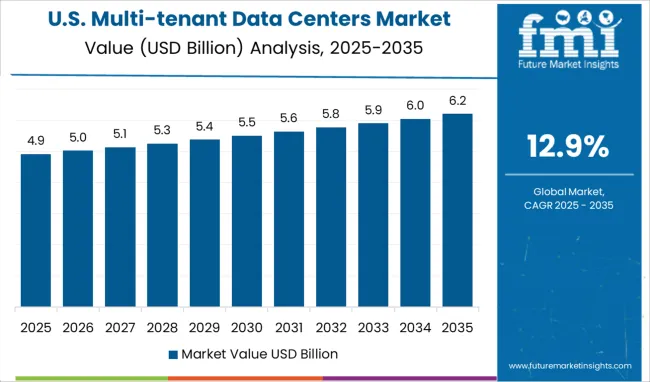
North America is currently the largest market for multi-tenant data centers, with a market share of 36.2%, and the share is anticipated to rise further during the forecast period.
The reason being the IT and data related industry is growing at a decent pace in this region, and with increased usage of SDDC in this region, the growth will only propel further. Moreover, the existence of competitive environment within various industries might also be instrumental in further increasing the market share in North America.
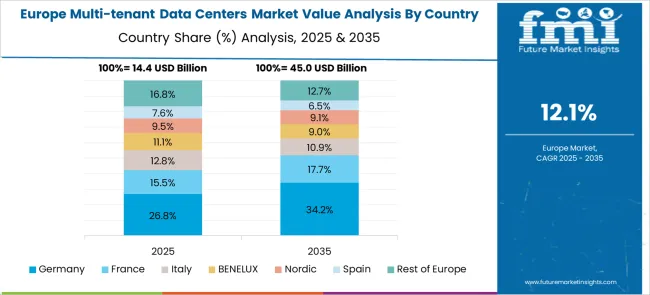
Europe, which has a market share of 24.1%, is also expected to exhibit growth during the forecast period.
A significant increase in the demand for such data centers by large scale businesses, and also evolving IT sector in this region is expected to drive the multi-tenant data centers market in this region.
With rapid penetration of internet, and increase in the adoption of IoT and AI ML as well, there is a lot happening in the start up ecosystem of multi-tenant data centers market.
Data center wholesale start up, Prime Data Centers has unveiled a new hyperscale data center facility in Silicon Valley as it continues to increase the data centers in California. If the sources are to be believed, even national expansion is not far away.
The 121000 square feet, 9-megawatt data center is located in Santa Clara, California. The focus will be on providing data centers to large enterprises and hyperscalers.
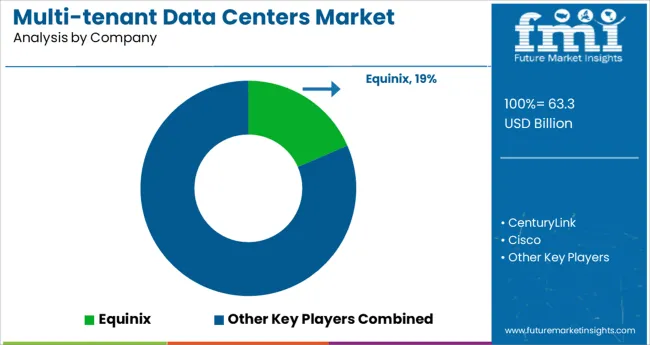
The multi-tenant data centers market share is expected to rise further. Some of the key players are: Ascenty, AT&T, CentriLogic, China Telecom, CenturyLink, Cisco, IBM Corporation, Digital Realty, Equinix Inc., RACKSPACE, Datapipe, Digiplex, DuPont Fabros, Global Switch, Level 3 Communications, and NTT Communications Corporation.
The main players are taking every possible step to increase the multi-tenant data centers market size. They are venturing into partnerships with various asset management firms for entering into real estate sectors and various other sectors to increase the market of multi-tenant data centers.
| Report Attribute | Details |
|---|---|
| Growth Rate | CAGR of 12.9% from 2025 to 2035 |
| Base Year for Estimation | 2024 |
| Historical Data | 2020 to 2024 |
| Forecast Period | 2025 to 2035 |
| Quantitative Units | Revenue in USD Million and CAGR from 2025 to 2035 |
| Report Coverage | Revenue Forecast, Volume Forecast, Company Ranking, Competitive Landscape, Growth Factors, Trends and Pricing Analysis |
| Segments Covered | Solution, Component, Application, Organisation Size, Industry, Region |
| Regions Covered | North America; Latin America; Europe; East Asia; South Asia; Oceania; Middle East and Africa |
| Key Countries Profiled | USA, Canada, Brazil, Argentina, Germany, UK, France, Spain, Italy, Nordics, BENELUX, Australia & New Zealand, China, India, ASEAN, GCC, South Africa |
| Key Companies Profiled | Ascenty; AT&T; CentriLogic; China Telecom; CenturyLink; Cisco; IBM Corporation; Digital Realty; Equinix Inc.; RACKSPACE; Datapipe; Digiplex; DuPont Fabros; Global Switch; Level 3 Communications; NTT Communications Corporation. |
| Customization | Available Upon Request |
The global multi-tenant data centers market is estimated to be valued at USD 63.3 billion in 2025.
It is projected to reach USD 213.0 billion by 2035.
The market is expected to grow at a 12.9% CAGR between 2025 and 2035.
The key product types are retail colocation and wholesale colocation.
solutions segment is expected to dominate with a 61.7% industry share in 2025.






Our Research Products

The "Full Research Suite" delivers actionable market intel, deep dives on markets or technologies, so clients act faster, cut risk, and unlock growth.

The Leaderboard benchmarks and ranks top vendors, classifying them as Established Leaders, Leading Challengers, or Disruptors & Challengers.

Locates where complements amplify value and substitutes erode it, forecasting net impact by horizon

We deliver granular, decision-grade intel: market sizing, 5-year forecasts, pricing, adoption, usage, revenue, and operational KPIs—plus competitor tracking, regulation, and value chains—across 60 countries broadly.

Spot the shifts before they hit your P&L. We track inflection points, adoption curves, pricing moves, and ecosystem plays to show where demand is heading, why it is changing, and what to do next across high-growth markets and disruptive tech

Real-time reads of user behavior. We track shifting priorities, perceptions of today’s and next-gen services, and provider experience, then pace how fast tech moves from trial to adoption, blending buyer, consumer, and channel inputs with social signals (#WhySwitch, #UX).

Partner with our analyst team to build a custom report designed around your business priorities. From analysing market trends to assessing competitors or crafting bespoke datasets, we tailor insights to your needs.
Supplier Intelligence
Discovery & Profiling
Capacity & Footprint
Performance & Risk
Compliance & Governance
Commercial Readiness
Who Supplies Whom
Scorecards & Shortlists
Playbooks & Docs
Category Intelligence
Definition & Scope
Demand & Use Cases
Cost Drivers
Market Structure
Supply Chain Map
Trade & Policy
Operating Norms
Deliverables
Buyer Intelligence
Account Basics
Spend & Scope
Procurement Model
Vendor Requirements
Terms & Policies
Entry Strategy
Pain Points & Triggers
Outputs
Pricing Analysis
Benchmarks
Trends
Should-Cost
Indexation
Landed Cost
Commercial Terms
Deliverables
Brand Analysis
Positioning & Value Prop
Share & Presence
Customer Evidence
Go-to-Market
Digital & Reputation
Compliance & Trust
KPIs & Gaps
Outputs
Full Research Suite comprises of:
Market outlook & trends analysis
Interviews & case studies
Strategic recommendations
Vendor profiles & capabilities analysis
5-year forecasts
8 regions and 60+ country-level data splits
Market segment data splits
12 months of continuous data updates
DELIVERED AS:
PDF EXCEL ONLINE
Data Security Posture Management (DSPM) Solutions Market Size and Share Forecast Outlook 2025 to 2035
Data Loss Prevention (DLP) Services Market Size and Share Forecast Outlook 2025 to 2035
Data Pipeline Observability Solutions Market Size and Share Forecast Outlook 2025 to 2035
Data Center Market Forecast and Outlook 2025 to 2035
DataOps Platform Market Size and Share Forecast Outlook 2025 to 2035
Datacenter Infrastructure Services Market Size and Share Forecast Outlook 2025 to 2035
Data Acquisition Hardware Market Size and Share Forecast Outlook 2025 to 2035
Data Center Automatic Transfer Switches and Switchgears Market Size and Share Forecast Outlook 2025 to 2035
Data Discovery Market Size and Share Forecast Outlook 2025 to 2035
Data Masking Technology Market Size and Share Forecast Outlook 2025 to 2035
Data Centre Rack Server Market Size and Share Forecast Outlook 2025 to 2035
Data Center Power Management Industry Analysis in Western Europe Size and Share Forecast Outlook 2025 to 2035
Data Center Power Management Industry Analysis in Korea Size and Share Forecast Outlook 2025 to 2035
Data Center Liquid Cooling Market Size and Share Forecast Outlook 2025 to 2035
Data Business in Oil & Gas Market Size and Share Forecast Outlook 2025 to 2035
Data Centre Colocation Market Size and Share Forecast Outlook 2025 to 2035
Data Lake Market Size and Share Forecast Outlook 2025 to 2035
Data Center RFID Market Size and Share Forecast Outlook 2025 to 2035
Data Center Accelerator Market Size and Share Forecast Outlook 2025 to 2035
Data Lakehouse Market Size and Share Forecast Outlook 2025 to 2035

Thank you!
You will receive an email from our Business Development Manager. Please be sure to check your SPAM/JUNK folder too.
Chat With
MaRIA